
Lathyrus latifolius, the perennial peavine, perennial pea, broad-leaved everlasting-pea, or just everlasting pea, is a robust, sprawling herbaceous perennial flowering plant in the pea family Fabaceae. It is native to Europe but is present on other continents, such as North America and Australia, where it is most often seen along roadsides.

Spartium junceum, known as Spanish broom, rush broom, or weaver's broom, it is a species of flowering plant in the family Fabaceae and the sole species in the genus Spartium. It is closely related to the other brooms.

Cosmos bipinnatus, commonly called the garden cosmos or Mexican aster, is a medium-sized flowering herbaceous plant in the daisy family Asteraceae, native to the Americas. The species and its varieties and cultivars are popular as ornamental plants in temperate climate gardens.

Mertensia virginica is a spring ephemeral plant in the Boraginaceae (borage) family with bell-shaped sky-blue flowers, native to eastern North America.

Pittosporaceae is a family of flowering plants that consists of 200–240 species of trees, shrubs, and lianas in 9 genera. Habitats range from tropical to temperate climates of the Afrotropical, Indomalayan, Oceanian, and Australasian realms. The type genus is Pittosporum Banks ex Gaertn.
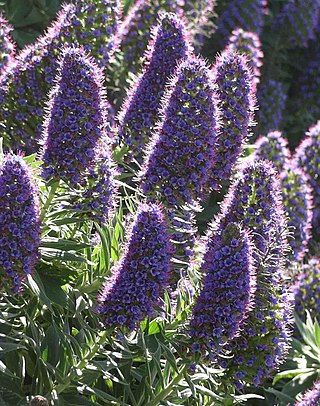
Echium candicans, the 'Pride of Madeira', is a species of flowering plant in the family Boraginaceae, native to the island of Madeira. It is a large herbaceous perennial subshrub, growing to 1.5–2.5 m.

Bursaria is a genus of eight species of flowering plants in the family Pittosporaceae and is endemic to Australia. They are shrubs or slender trees, often with spiny branches and have simple leaves, relatively small flowers with five sepals, five petals and five stamens, and fruit that is a flattened, thin-walled capsule.
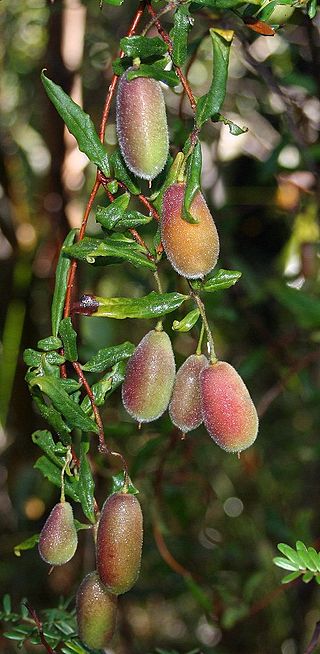
Billardiera, commonly known as appleberries, snot berries, or bluebell creepers, is a genus of flowering plants in the family, Pittosporaceae and is endemic to Australia. Plants in the genus Billardiera are woody scramblers, climbers or twiners with elliptic, lance-shaped or linear leaves arranged alternately along the stems, the flowers with petals that are joined to form a tube at the base with spreading lobes, and succulent or fleshy fruit.

Bursaria spinosa is a small tree or shrub in the family Pittosporaceae. The species occurs mainly in the eastern and southern half of Australia and not in Western Australia and the Northern Territory. Reaching 10 m (35 ft) high, it bears fragrant white flowers at any time of year but particularly in summer. A common understorey shrub of eucalyptus woodland, it colonises disturbed areas and fallow farmland. It is an important food plant for several species of butterflies and moths, particularly those of the genus Paralucia, and native bees.
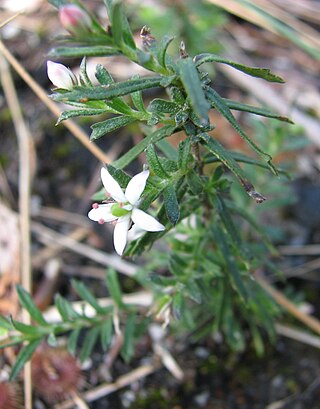
Rhytidosporum is a genus of flowering plants within the family Pittosporaceae. The type species is Rhytidosporum procumbens (Hook.) F.Muell.
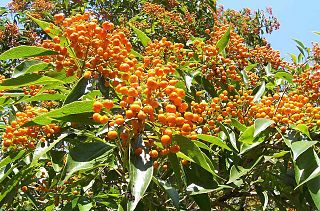
Auranticarpa is a genus of trees in the family Pittosporaceae. All six species occur in monsoonal forest and rainforest margins in Northern Australia. The species, all formerly included in the genus Pittosporum, are as follows:
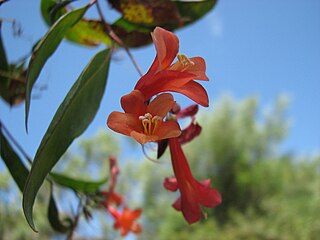
Marianthus is a genus of flowering plants within the family Pittosporaceae.

Pittosporum angustifolium is a shrub or small tree growing throughout inland Australia. Common names include weeping pittosporum, butterbush, cattle bush, native apricot, apricot tree, gumbi gumbi, cumby cumby, meemeei, poison berry bush, and berrigan.

Thunbergia grandiflora is an evergreen vine in the family Acanthaceae. It is native to China, India, Nepal, Bangladesh, Indochina and Myanmar and widely naturalised elsewhere. Common names include Bengal clockvine, Bengal trumpet, blue skyflower, blue thunbergia, blue trumpetvine, clockvine, skyflower and skyvine.

Billardiera fraseri is a species of plant in the family, Pittosporaceae, which is endemic to Western Australia.

Billardiera fusiformis is a species of plant in the family, Pittosporaceae, which is endemic to Western Australia.

Billardiera drummondii is a slender climber in the Pittosporaceae family, native to the south-west of Western Australia, which grows in Eucalypt woodland on coastal soils. Its flowers are blue to purple and seen in January.
Lindy Webster Cayzer CF is an Australian botanist.
Rhytidosporum inconspicuum is an inconspicuous, rhizomatous shrub in the pittosporum family, Pittosporaceae. The species is found in New South Wales, Victoria and Tasmania.

















